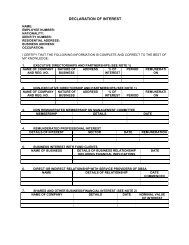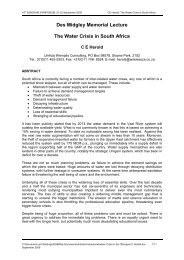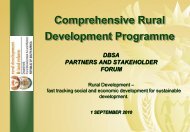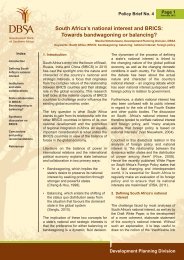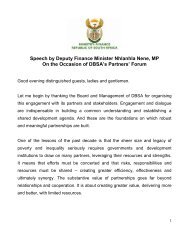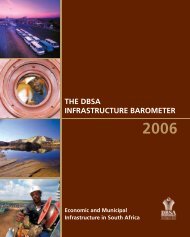ANNUAL REPORTS
ANNUAL REPORTS
ANNUAL REPORTS
You also want an ePaper? Increase the reach of your titles
YUMPU automatically turns print PDFs into web optimized ePapers that Google loves.
Macroeconomic overview continued<br />
momentum as the year progressed. Other constraining<br />
factors were the strong currency, which affected the<br />
competitiveness of the local industry in general; weak<br />
economic conditions in Europe, an important trading partner;<br />
and poor employment growth after substantial job shedding<br />
since 2009, which added to the high levels of structural<br />
unemployment. This underscored the contrasting conditions<br />
between those in formal employment who were able to secure<br />
significant real wage increases and those without jobs who<br />
experienced increased financial stress and deepening<br />
poverty. It underlines the need for a growth path for the<br />
economy that can deliver faster and more inclusive growth<br />
on a sustained basis. It is only through greater job creation<br />
that sustainable incomes can be generated to reduce<br />
poverty and inequality. In this context, the five priorities of<br />
government target massive job creation in the next ten years,<br />
through a number of mechanisms, to raise the rate of growth<br />
and labour absorption.<br />
Significant increases in global commodity prices, combined<br />
with above-inflation wage settlements and increases in<br />
administered prices for fuel, electricity and other local<br />
government services potentially posed inflation dangers<br />
to the economy. In the event, however, the strong rand,<br />
underpinned by strong inflows of portfolio investment from<br />
abroad, effectively shielded the domestic economy from<br />
the worst of the offshore cost pressures. A lack of demand<br />
pressures in the domestic economy further supported low<br />
inflation, enabling the monetary authorities to continue to<br />
facilitate the economic recovery through low interest rates.<br />
However, if the rand weakens, fuel prices remain high and<br />
the mooted administered price increases go ahead, the<br />
economy faces significant inflation dangers; the monetary<br />
authorities might well raise interest rates sooner than would<br />
otherwise have been the case.<br />
The DBSA<br />
The DBSA’s operating environment continued to present<br />
substantial challenges. In some respects, the global recovery<br />
and better economic conditions in South Africa and the<br />
region assisted the Bank. However, the sectorally and<br />
spatially unbalanced nature of the recovery in South Africa<br />
and deeply rooted structural challenges in the DBSA’s<br />
mandate space made for a difficult environment in which<br />
to achieve ambitious objectives.<br />
On the positive side, the better performance of many SADC<br />
economies and the favourable regional fundamentals after<br />
a difficult 2009/10 improved the climate for the Bank’s<br />
regional investment activities. Returning risk appetite among<br />
global investors and a positive outlook for emerging markets<br />
and commodity-producing countries improved investment<br />
inflows to the region. Significantly improved liquidity in global<br />
financial markets assisted with access to capital markets,<br />
although the return of the corporate sector to the global<br />
markets widened the investment options for investors and<br />
introduced more competitive issuance dynamics into the<br />
primary capital markets.<br />
In South Africa, the need for accelerated investment in social<br />
and economic infrastructure remained pressing. However,<br />
the Bank’s performance was constrained by a number of<br />
factors. These included the uneven economic recovery,<br />
which affected the financial position of many public and<br />
private sector clients; the structurally weak financial position<br />
of many municipalities; low interest rates, which negatively<br />
affected interest income from the Bank’s investments; and,<br />
most importantly, the lack of institutional capacity at various<br />
levels of government to plan, fund and execute infrastructure<br />
projects. This last factor in particular contributed to the<br />
operational challenges faced by the Bank in accelerating<br />
its public sector lending. As a result, the Bank made a<br />
considerable effort to address these problems through<br />
research, capacity building and assistance with programme<br />
development and project management.<br />
In the year ahead, the global economic recovery should<br />
continue, but in all likelihood, at reduced momentum. Recently,<br />
downside risks to the recovery have been rising owing to<br />
escalating sovereign debt and fiscal difficulties in Europe<br />
and the United States. Business and investor confidence<br />
are being impacted in the process, governments are<br />
facing further difficult policy and political dilemmas and the<br />
resilience of the global financial system is being tested once<br />
again. This in a situation where high commodity prices, in<br />
particular energy and food, have already impacted negatively<br />
on global growth, and overheating risks in the key economies<br />
driving the global recovery have elicited policy tightening<br />
and resultant easing growth. Global financial markets<br />
remain fragile and over the next two years will be tested by a<br />
series of large, crisis-related debt rollover thresholds. In this<br />
setting, economic performance in sub-Saharan Africa<br />
is nevertheless expected to remain favourable, but in<br />
South Africa it is likely that the economic recovery will be slow<br />
to gain progressive traction.<br />
For the DBSA, operating conditions in South Africa will remain<br />
difficult, given the challenges of securing a flow of bankable<br />
infrastructure projects from the public sector. The Bank will<br />
continue to support the government in policy and strategy<br />
development, project and programme development and<br />
management, and skills development in the public sector.<br />
Continued low interest rates will affect interest income for<br />
much of the year, although rates are likely to rise before<br />
the end of the financial year. Furthermore, the Bank’s<br />
operating expenses are likely to remain under pressure as<br />
administered prices, in particular energy prices, contribute to<br />
higher input costs.<br />
24 DBSA DBSA | <strong>ANNUAL</strong> | <strong>ANNUAL</strong> REPORT REPORT 2010/11 2010/11



